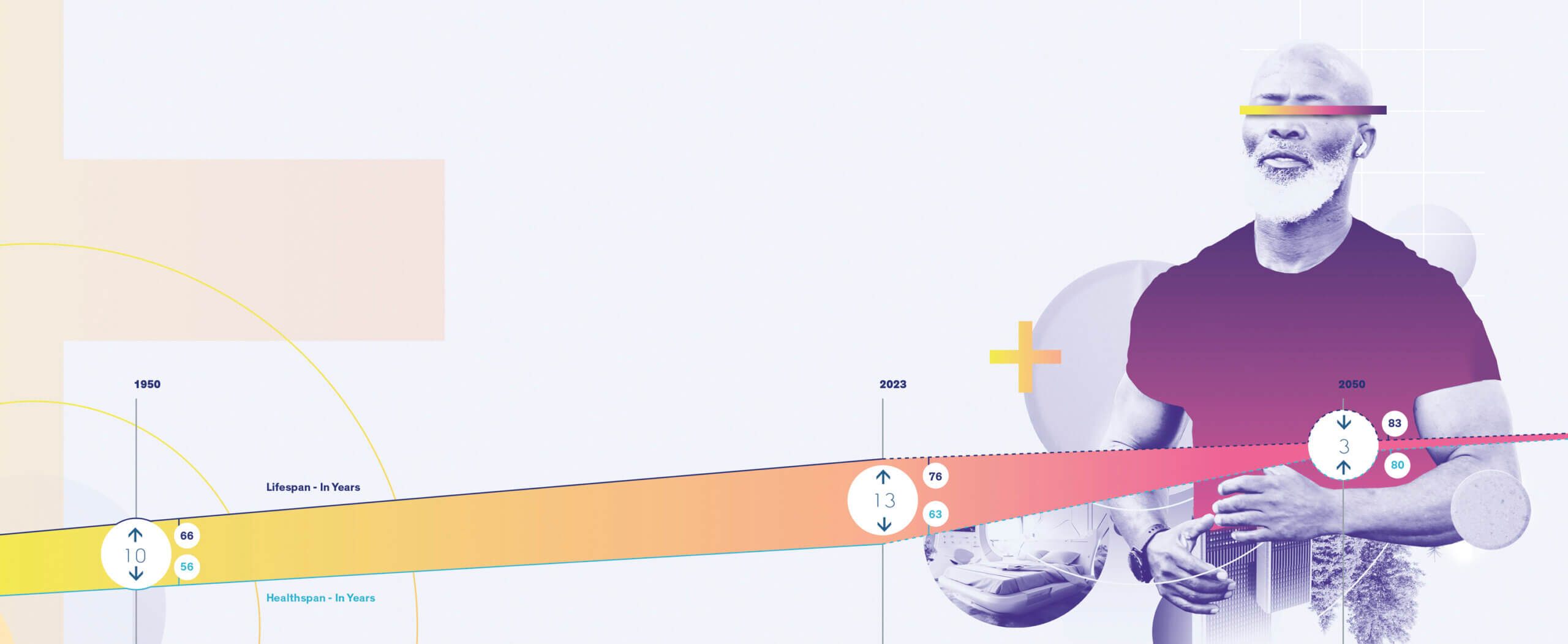-
50%of US healthcare costs occur in the last 3 years of life
-
25%of healthcare costs occur in the last 12 months of life
-
$37Tamount contributed to the global economy by 1 extra year of healthy life
The new science of antiaging is rapidly changing the perception that diseases like Alzheimer’s, heart disease, diabetes and arthritis are distinct and separate. It’s becoming clear that they share many underlying biological processes associated with the human organism growing old. Scientists have narrowed these down, broadly, into nine “hallmarks of aging,” such as stem cell exhaustion, inflammation and cellular senescence.
Modern longevity science began in 1993 when structural biologist Cynthia Kenyon of the University of California, San Francisco, discovered that modifying a single gene in a tiny worm called Caenorhabditis elegans could double its lifespan. Her findings suggested that aging might be regulated by genes in some organisms, an insight that inspired a broad scientific inquiry around antiaging. Researchers have since been able to extend the lifespan of worms tenfold and of mice by a third. In some cases they have reversed aging in animals as measured by biomarkers. So far, scientists have not gotten the same results in humans, although currently at least 10 drugs targeting aging pathways are in clinical trials.
TRENDING: LONGER LIVES
Since 1900, when average life expectancy in America was 47 years, Americans have gained about 2.65 years on average every decade. The United Nations has predicted that by the end of the 21st century the average lifespan will max out in the upper 90s. But new interventions to slow aging are poised to bend the curve upward again.
Within a decade, 70 will be the new 50.
James Peyer
CEO and cofounder, Cambrian Biopharma
AMERICAN ASTERISK: US LIFESPANS ARE REVERSING THANKS TO COVID, DRUG ABUSE AND OBESITY
Life expectancy in America fell to 76.1 years in 2021, down from 79 years in 2019. Driven by Covid, opioid overdoses and obesity, 2022 saw the second consecutive annual fall. These reversals brought to a halt a century plus of extraordinary gains. The longterm trend is likely to resume, given the resources pouring into longevity innovation. Other factors: a massive public health effort to fight Covid (despite political challenges) and long-overdue government-level actions against Purdue Pharma and other corporations that fueled the surge of premature deaths caused by the opioid epidemic.
How Do We Get There?
Leaps in lifespan have historically raced ahead of science’s ability to maintain healthspan. By the age of 65, 80% of Americans typically suffer from one chronic “disease of aging.” By 70, most are dealing with two such conditions, making aging beyond a certain point something to endure, not to look forward to.
Gains in lifespan in the near future will be incremental and measured in months or a small number of years. For instance, if cancer were cured tomorrow, the average lifespan would rise by just 2.5 years. Scientists are developing a menu of incremental treatments and approaches for a variety of diseases and conditions that together will expand this equation and alter what it means to age. Getting older is likely to get better.
A new generation of companies is emerging that hope to translate decades of lab work into decades of additional healthspan. Approaches vary wildly and include:
-
01
Age Reversal Therapies
The emerging field of epigenetics focuses on how changes in lifestyle, nutrition and environment affect how one’s genes work. By tweaking the mechanisms of epigenetics that turn genes on and off, scientists have succeeded in reprogramming mouse cells to make them act genetically younger. Animal researchers are discovering that an extra bit of a vitamin, physical exercise, a brief exposure to a toxin, and even an added dose of maternal nurturing can send signals through our epigenome and have lifelong impacts on the body and brain. The epigenetic connection to brain health in the elderly is proving a particularly promising area for researchers.
-
02
Synthetic Biology
Therapeutics that use bioengineered cells to correct genetic mutations and to repair damaged tissue are in the early stages of being tested in human clinical trials, often on patients with rare diseases that strike younger people. Vita Therapeutics, for example, is close to launching clinical trials of a treatment for Limb-Girdle Muscular Dystrophy, which typically affects children. The company’s technology creates stem cells derived from a patient’s own cells that its scientists then gene-edit using CRISPR to correct a mutation that causes the disease. The goal is to prove efficacy in children, and then to seek a much broader use for older patients who more broadly suffer from muscle wasting.
-
03
Phenomics
This new field aims to collect, monitor and analyze with AI a host of biomarkers—including DNA, proteins and other molecular markers—that can be used to better predict and prevent disease. One use of this data: polygenic embryo testing, used to predict the chance of disease. These tests, available in fertility clinics today, analyze embryonic chromosomes and assign them a score based on the likelihood that they will develop diseases like cancer and diabetes. (For more on phenomics, see the Self-Health Rising, Future vs. Cancer and Wellness and Nutrition sections.)
-
04
The Immune System
Scientists are working to better understand the role of the immune system in virtually all diseases, including efforts by the newly launched Human Immunome Project based in New York City that is setting out to research a project on the scale of the Human Genome Project. Better vaccines using new technologies like mRNA will expand over the next few years along with other interventions that bump up the immune system to fend off diseases. Exciting approaches are emerging to activate the immune system to kill cancer cells. New therapeutics use monoclonal antibodies to disable viruses and bacteria, and bioengineered CAR T cells to attack and hopefully destroy tumors. (For more on cancer and the immune system, see the Future vs. Cancer section.)
-
05
Machine Solutions
Yet another tack to extending lifespan is building better-engineered spare parts, including human-engineered prosthetics, 3D-printed organs, better hip, knee and other replacements, and lifesaving devices like pacemakers. (For more on machine solutions, see the Make Me Bionic section.)
This emergence of antiaging science is a new public health paradigm and its impact will be on the order of magnitude of the introduction of basic public health in the early part of the 20th century, or antibiotics and vaccines in the middle of the 20th century.
Jay Olshansky
University of Illinois School of Public Health
A pill that dramatically increases lifespan does not yet exist. But scientists are working with compounds like NAD+, thought to promote longevity. More drugs will be coming that will slow down cell death and activate telomere maintenance and other antiaging mechanisms.
These drugs include metformin, a generic diabetes treatment that has been on the market for more than 60 years. Analysis of more than 70,000 diabetics taking metformin saw a 17% reduction in mortality compared to the general population. Researchers believe metformin will have similar or better results in nondiabetics, but so far advocates have not been able to raise the funds for a clinical trial to test this hypothesis. Another repurposed longevity drug to watch: rapamycin, an mTOR inhibitor that is prescribed to prevent organ rejection and has been shown in animal studies to extend life
Right now the most accurate predictor of lifespan—by correlation, not causality— is the ZIP code a person inhabits. In California’s Marin County, average life expectancy is 85. In one ZIP code of Fort Worth, Texas, life expectancy is just 66. Location reveals the impact on longevity of the exposome—the exposures one encounters from diet and lifestyle to environmental and occupational risks. Higher-income areas tend to have longer life expectancy, directly related to better access to healthcare and healthy foods, and overall better living conditions. (For more on longevity and location, see the Politics and Healthcare section.) Socioeconomics also has a huge impact on the exposome, with residents of low-income areas exposed to poor diets, unsafe levels of chemicals and high rates of crime. Solutions include offering federal funds, especially in underserved communities, to open greengrocers in food deserts and building sidewalks and other pedestrianized zones to promote walking. Quality nutrition and regular exercise remain the best antiaging medicines. According to the USDA, an area is considered a food desert if at least 500 people or 33% of the population live more than one mile (in urban areas) or 10 miles (in rural areas) from the nearest supermarket or large grocery store. Income levels also factor in: places with a poverty rate of 20% or greater, or a median family income at or below 80% of the statewide or metropolitan area figure, are considered food deserts.
EXPOSOME, AVERAGE LIFE EXPECTANCY
-
85Marin County, CA
-
65Fort Worth, TX
Apps and programs assessing a person’s “biological age” will improve, combining genetics and phenomics with measurements of sleep, exercise and diet. A new crop of longevity therapies will lead to an era when counting one’s steps will turn into counting one’s biological years. Bryan Johnson, a 45-year-old software mogul turned neurohacker and life extension guinea pig, has created Rejuvenation Olympics, a website that displays a leaderboard of the top 20 age reduction scores from among thousands who have submitted their epigenetic analyses to the competition. A wave of new consumer brands will follow suit in the coming decade, turning longevity into a trend where people compete with each other to turn back their biological clocks with lifestyle changes and drug interventions.
A MALTHUSIAN CASE
Increased longevity, unevenly distributed, will lead to societal conflict. It goes like this: As a wealthy few live longer, more productive lives, Western centenarians suck more resources away from poorer, sicker nations. Younger generations revolt against their vibrant elders who stay in work longer, depriving the youth of opportunities, ushering in an era of violent upheaval.
A MORE LIKELY SCENARIO
Investment in antiaging research— including regenerative therapies, gene editing and advanced bionics— pays off as the world wakes up to the idea that aging is not something we must simply accept, but a condition that can be treated like any other. If these advances are shared equitably, increased healthspan will unleash an economic boom powered by the “longevity dividend,” as people work and contribute to the global economy for more years and spend less time in the hospital. “Late-life universities” will spring up to retrain healthy 60- and 70-year-olds who want to change careers. A recent study in Nature estimates that one extra year of healthy life for everyone on Earth would contribute $37 trillion to the global economy.

